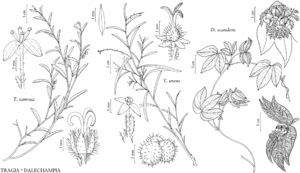Dalechampia
Sp. Pl. 2: 1054. 1753.
| Taxon | Illustrator ⠉ | |
|---|---|---|
 | Dalechampia scandens Tragia urens Tragia ramosa | Barbara Alongi Barbara Alongi Barbara Alongi |
Vines [lianas or shrubs], twining [trailing], monoecious [gynodioecious]; hairs unbranched, always some stinging [none stinging, sometimes glandular]; latex absent. Leaves deciduous [persistent], alternate, simple [palmately compound]; stipules present, persistent; petiole present, glands absent; stipels present, often with basal glands; blade palmately lobed [unlobed], margins serrulate-crenulate [subentire], laminar glands absent; venation palmate [pinnate]. Inflorescences bisexual, apparently axillary (technically terminal on axillary short-shoots), pseudanthia (consisting of 2, often showy, involucral-bracts subtending 2 cymules, one with [1–] 3 pistillate flowers and 1–3 involucellar bractlets, and one with [4–] 10 [–40] staminate flowers, 1–5 involucellar bractlets, and a series of resiniferous [non-resiniferous] bractlets forming condensed gland; involucral-bracts open when flowers receptive, enveloping fruits [deciduous] as seeds develop); glands subtending each bract 0. Pedicels present. Staminate flowers: sepals 3–6, valvate, distinct; petals 0; nectary absent; stamens [5–] 25–35 [–90], distinct, borne on elongated [flat, dome-shaped] receptacle, thus appearing connate proximally; pistillode absent. Pistillate flowers: sepals [5–] 8–12, distinct; petals 0; nectary absent; pistil 3-carpellate; style 1, unbranched. Fruits capsules. Seeds globose to subglobose; caruncle absent. x = 11, 13.
Distribution
Introduced; Fla., Mexico, West Indies, Central America, South America, s, se Asia, Africa, Indian Ocean Islands (Madagascar), Pacific Islands (Java), Pacific Islands (Sumatra)
Discussion
Species ca. 130 (1 in the flora).
Some species of Dalechampia are cultivated as ornamentals in North America, notably D. aristolochiifolia Kunth and D. spathulata (Scheidweiler) Baillon. The former is grown outdoors in the southern United States and may naturalize in the future, especially in peninsular Florida, where its specialized pollinator Euglossa viridissima Friese has become naturalized (R. W. Pemberton and H. Liu 2008). Dalechampia scandens can be distinguished from D. aristolochiifolia by the latter’s pink bracts and from D. spathulata by the latter’s monopodial-shrubby habit.
Selected References
Lower Taxa
"elongated" is not a number."connate" is not a number. "distinct" is not a number.